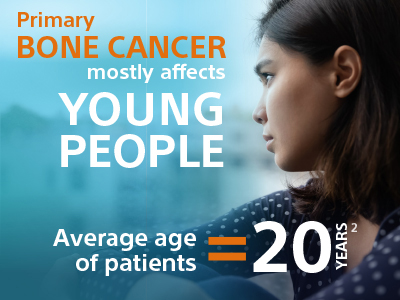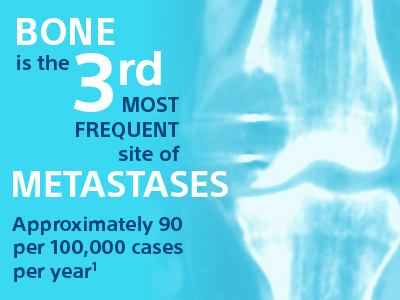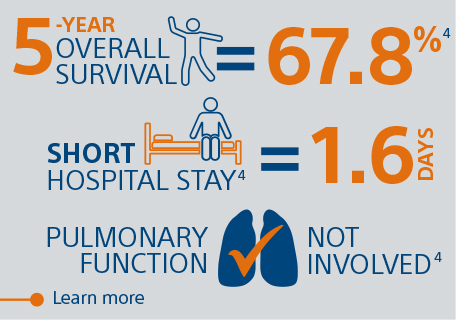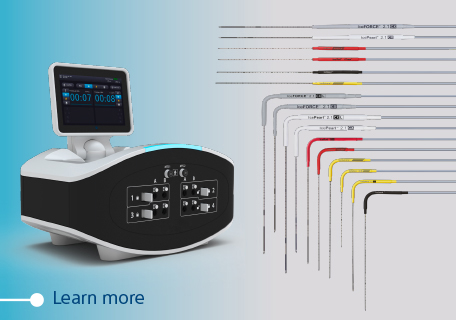Medical Specialties > Interventional Radiology > Ablation Solutions > Cryoablation Indications > Bone Cancer
Bone Cancer
Bone Cancer is very rare: it represents about <0.2 % of all malignant tumours (the numbers vary country by country). As the name implies, malignant bone tumours are found throughout the bones of the body.
Bone cancer, also known as bone sarcoma, can be classified as primary or secondary:
- Primary bone cancer begins in the bone
- Secondary bone cancer begins in another organ but the cancer cells spread to the bones (~ 90/ 100,000/ year)1
Primary bone cancer can occur in any bone in the body but is very rare (<0.2% of all malignant tumours, although the numbers vary by country).
Secondary bone cancer is becoming more common as the survival rates for many cancers improve, giving more time for the cancer to spread into the bone.


Subtypes
Tumour Subtype |
Incidence (per 100,000 per year) |
Description |
Use of CA |
|
Bone Metastases |
90A |
•Most commonly occurs in the spine, pelvis and thigh; associated with fracture and pain - Tx usually focused on slowing growth/ improving QoL, rather than cureB
|
•CA included in ESMO guidelines as a special consideration for relieving pain from spinal metastasesC
•Large multicentre studies also support use of CA for pain palliationD,E,F
|
|
Osteosarcoma (malignant) |
0.27G (0.8-1.1)H |
•Usually arises in the metaphysis of a long bone, most commonly around the knee; occurs most frequently in adolescentsI
|
•Cryotherapy included in ESMO guidelines as alternative option for patients unfit for surgery who have recurrent osteosarcoma lung metastasesH
|
|
Ewing’s Sarcoma (malignant) |
0.28G,H (2.93)J |
•Mostly found in legs & arms (50%) and the pelvic bones (25%), followed by the ribs and spine; occurs most frequently in children and adolescentsI
|
||
Chondrosarcoma (intermediate – locally aggressive, or malignant) |
0.2-0.41G,H |
•Bone sarcoma that develops in the cartilage cells with the most common sites being the upper arm, pelvis and thigh bone; usually affects adults above the age of 40K
|
•Cryotherapy included in ESMO guidelines as a local adjuvant to curettage for Grade 1 atypical cartilaginous tumours (intermediate – locally aggressive)H
|
|
Chordoma (malignant) |
0.05-0.12G,H |
•Rare spinal tumours that usually develop around the neck or pelvis; most commonly affects adults in their 40’s and 50’sK
|
•CA included in ESMO guidelines as a pain palliation Tx for recurrent extracranial chordomasH
|
|
Giant Cell Tumours (intermediate - locally aggressive, or intermediate - rarely metastasising, or malignant) |
0.1H |
•Benign tumours that predominantly occur in the long bones of the arms and legs (always found at the end of the bone next to the joint); most frequent in young adultsK
|
•Retrospective studies support use of CA for Tx of benign/ intermediate bone tumoursL,M,N
Incidence of all benign bone tumour subtypes is ~ 2.6/ 100,000/year* |
•Cryotherapy included in ESMO guidelines as a local adjuvant to surgery/ curettageH
|
Osteoid Osteoma (benign) |
0.1Q,R |
•Benign tumours that usually develop in the long bones and tend to be small (< 1.5 cm); typically occur in children/adolescentsS
|
•RFA already considered ‘gold-standard’ Tx
•Systemic review suggests CA may be a preferable option (improved safety near critical nerves and spinal chord, potential immunotherapy benefit)L
|
|
Osteoblastoma (intermediate - locally aggressive) |
< 0.1Q,R |
•Closely related to osteoid osteoma, however, they are larger (> 1.5-2 cm) and more likely to affect the axial skeleton; usually present in young adultsS
|
||
Aneurysmal Bone Cysts (intermediate - locally aggressive) |
0.14T,U |
•Blood-filled, fibrous, tumour-like cysts which most commonly appear in the vertebrae and knee; generally occur in young adultsV
|
•Cryotherapy considered as a local adjuvant to curettageW,Y
|
|
Treatment options



The treatment strategy depends on different aspects: type of bone cancer, stage of disease and general health status of the patient. The most common treatments are:1, 3
- External beam RT (EBRT)
- Endocrine treatments
- Surgery
- Chemotherapy
- Immunological therapies
- Radiofrequency Ablation
- Cryoablation
Clinical Results – Why Cryoablation?
Discover Cryoablation for Bone Metastases
“Bone tumour cryoablation is a safe procedure with a
very low rate of major complications.”
Auloge P et al. 2019. University Hospital of Strasbourg, France
Cryoablation is an effective treatment for palliating painful musculoskeletal metastases and achieving local tumour control. Recent studies have demonstrated that Cryoablation provides high efficiency in defeating malign metastatic bone tumours and a high percentage of survivals (5-year overall survival: 67.8%).4
Defeat the pain with Cryoablation!
“Pain, especially bone pain, is the most common
symptom in malignancy patients, which seriously
affects the life quality of patients with cancer.”
Zhu XC et al. 2015
Bone metastases have significant impact on quality of life and their prevalence is increasing as survival rates for cancer patients improve.5,6
A recent study (Cryoablation for Palliation of Painful Bone Metastases: The MOTION Multicenter Study)has demonstrated that Cryoablation of metastatic bone tumors provided rapid and durable pain palliation, improved quality of life7,8 and offered an alternative to opioids for pain control.8,9
Our Solutions
Cryoablation is a minimally invasive treatment that uses extreme cold to freeze and destroy diseased tissue, including cancer cells. We offer a broad portfolio of Systems and Needles, that, thanks to the latest technology, provide an efficient treatment against tumours.
Learn more about our solutions
CAUTION: The law restricts these devices to sale by or on the order of a physician. Indications, contraindications, Warnings and instructions for use can be found in the product labelling supplied with each device. Information for the use only in countries with applicable health authority product registrations. Material not intended for use in France.


















